During your holiday, if you wish to go for a walk in the forest or hike in the mountains near Annecy, you will have the opportunity to contemplate an exceptional wildlife.
Haute-Savoie is a department of the Northern Alps which has a huge natural area preserved from construction and roads. Its lakes and rivers are home to many forms of fish. It is the reservoir of a great biodiversity composed of common species, but also of rarer species. During your walks in the forest, it is possible to come across a wild boar or a deer, so you need to know how to react to a wild animal?
Vegetarian mammals
In our forests, you can observe the tracks of many wild animals. They can be found up to 3,000 metres above sea level.
The marmot
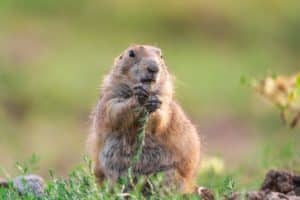 If you are patient and have binoculars, you may be lucky enough to spot marmots in the mountain pastures. This animal lives in groups and there is always a watchman who emits a whistle when an intruder approaches. It is not visible during the winter, as it hibernates in its burrow.
If you are patient and have binoculars, you may be lucky enough to spot marmots in the mountain pastures. This animal lives in groups and there is always a watchman who emits a whistle when an intruder approaches. It is not visible during the winter, as it hibernates in its burrow.
The mountain hare
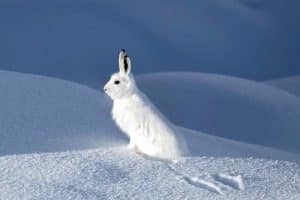 The mountain hare is characteristic of the fauna of the Alps, as its brown coat turns white during the snowy season to better blend in with the landscape. Its droppings are easily recognisable, in the form of small black balls, and indicate its presence in an area of the forest.
The mountain hare is characteristic of the fauna of the Alps, as its brown coat turns white during the snowy season to better blend in with the landscape. Its droppings are easily recognisable, in the form of small black balls, and indicate its presence in an area of the forest.
The deer and the doe
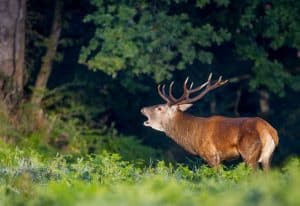 This large mammal, which can reach the size of a horse, is common in the mountains. The stag’s bellow is a time of year when it makes a loud sound during the breeding season. Its hoof makes a characteristic mark on the ground. The doe often travels in the company of her young, the fawn.
This large mammal, which can reach the size of a horse, is common in the mountains. The stag’s bellow is a time of year when it makes a loud sound during the breeding season. Its hoof makes a characteristic mark on the ground. The doe often travels in the company of her young, the fawn.
The roe deer
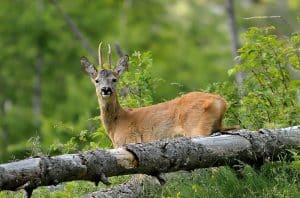 Like the stag, this mammal is common in Haute-Savoie. Its habitat is mainly forest and its hooves are thinner than those of the deer, which means that its tracks are less pronounced in the ground or snow. The roe deer sometimes travels in groups with its young.
Like the stag, this mammal is common in Haute-Savoie. Its habitat is mainly forest and its hooves are thinner than those of the deer, which means that its tracks are less pronounced in the ground or snow. The roe deer sometimes travels in groups with its young.
Ibex
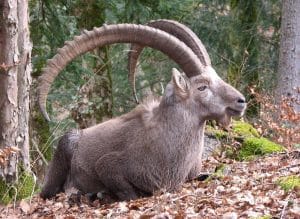 This animal lives in the steep areas of our mountains. It can easily be observed with binoculars as it does not like the forest. The large horns of the males can reach up to 1 m in length. The ibex is not very shy, but you should go and discover it in the mountains up to 3,000 metres in altitude. In summer, it goes down to graze on the soft grass.
This animal lives in the steep areas of our mountains. It can easily be observed with binoculars as it does not like the forest. The large horns of the males can reach up to 1 m in length. The ibex is not very shy, but you should go and discover it in the mountains up to 3,000 metres in altitude. In summer, it goes down to graze on the soft grass.
The chamois
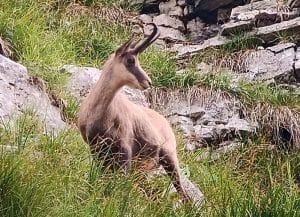 Smaller than the ibex, the chamois is very present at medium altitude. Its vegetarian diet consists mainly of grasses and young shoots. Its preferred habitat is in forests and in the pastoral mountains of Savoy between 800 m and 2,300 m altitude. Its head is adorned with two hook-shaped horns.
Smaller than the ibex, the chamois is very present at medium altitude. Its vegetarian diet consists mainly of grasses and young shoots. Its preferred habitat is in forests and in the pastoral mountains of Savoy between 800 m and 2,300 m altitude. Its head is adorned with two hook-shaped horns.
The wild boar
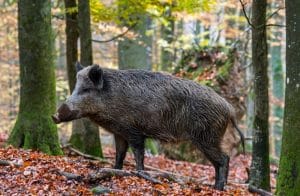 This mammal, a cousin of the domestic pig, has a population of nearly 5,000 animals in Haute-Savoie. It lives mainly in the forest, but can also feed on the plains. Vegetarian, it consumes mainly acorns and chestnuts. This powerful animal measures up to 150 cm long and weighs up to 100 kg. It is the most hunted species.
This mammal, a cousin of the domestic pig, has a population of nearly 5,000 animals in Haute-Savoie. It lives mainly in the forest, but can also feed on the plains. Vegetarian, it consumes mainly acorns and chestnuts. This powerful animal measures up to 150 cm long and weighs up to 100 kg. It is the most hunted species.
Carnivorous mammals
For the food chain to function, there are also many predators in the Haute-Savoie.
The fox
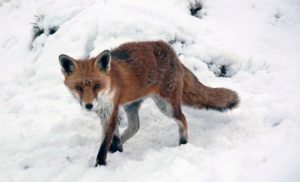 This forest-dweller is also found in the plains, and it is not unusual to see it near towns and farms. Rather solitary, it feeds on rodents such as hares, rabbits, mice and voles. It may also eat some plants and attack cats and farm chickens.
This forest-dweller is also found in the plains, and it is not unusual to see it near towns and farms. Rather solitary, it feeds on rodents such as hares, rabbits, mice and voles. It may also eat some plants and attack cats and farm chickens.
The lynx
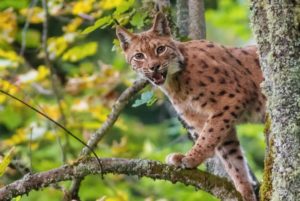 This fearsome predator is regularly seen in the department’s mountain ranges. Its habitat is in the forest where it can easily position itself on the branches of trees. Its food consists of squirrels, rats and numerous birds such as grouse and blackbirds. It is difficult to observe because it is mainly active at night.
This fearsome predator is regularly seen in the department’s mountain ranges. Its habitat is in the forest where it can easily position itself on the branches of trees. Its food consists of squirrels, rats and numerous birds such as grouse and blackbirds. It is difficult to observe because it is mainly active at night.
The wolf
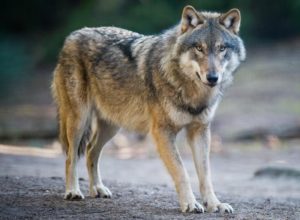 Reintroduced in France a few years ago, this large carnivore is present in the Aravis mountain range between Savoie and Haute-Savoie. The French Office for Biodiversity estimates that 624 wolves are present in this massif. They fear humans and are therefore very difficult to observe. Its food consists of deer, roe deer, wild boar, chamois, mouflons and also farm animals.
Reintroduced in France a few years ago, this large carnivore is present in the Aravis mountain range between Savoie and Haute-Savoie. The French Office for Biodiversity estimates that 624 wolves are present in this massif. They fear humans and are therefore very difficult to observe. Its food consists of deer, roe deer, wild boar, chamois, mouflons and also farm animals.
The ermine
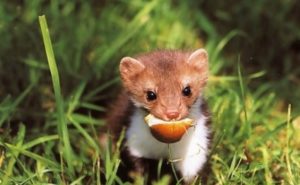 This small carnivorous mammal is present in Haute-Savoie near water. It feeds on small mammals, mice, shrews, voles and also frogs, birds and their eggs. It can be found in mountainous areas between 1,000 and 2,000 m in altitude, but also on the plains near crops.
This small carnivorous mammal is present in Haute-Savoie near water. It feeds on small mammals, mice, shrews, voles and also frogs, birds and their eggs. It can be found in mountainous areas between 1,000 and 2,000 m in altitude, but also on the plains near crops.
The weasel
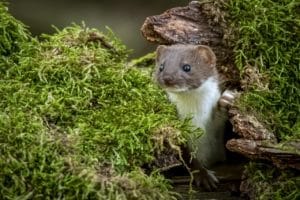 This small carnivore is a formidable hunter, preying on small rodents, eggs and birds. It is present throughout our department. A daytime hunter, it is difficult to observe and lives alone outside of the June to August breeding season.
This small carnivore is a formidable hunter, preying on small rodents, eggs and birds. It is present throughout our department. A daytime hunter, it is difficult to observe and lives alone outside of the June to August breeding season.
Typical birds of the Savoie
Haute-Savoie has most of the bird species found in France, with the exception of species specific to the seaside. It also hosts much rarer species in the mountains and on the lake.
The swan
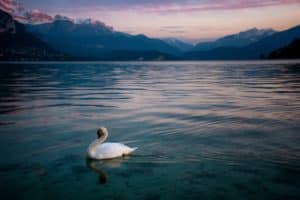 This emblematic bird of Lake Annecy breeds in the reed beds. It feeds mainly on algae and grass. It can also be seen out of the water on the Pâquier in Annecy. Initially, this large white bird with an orange bill was migratory. The swan population on the lake is now essentially sedentary.
This emblematic bird of Lake Annecy breeds in the reed beds. It feeds mainly on algae and grass. It can also be seen out of the water on the Pâquier in Annecy. Initially, this large white bird with an orange bill was migratory. The swan population on the lake is now essentially sedentary.
The mallard
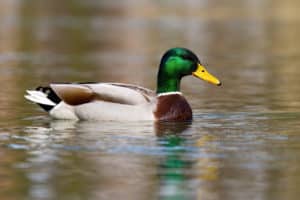 This species of wild duck lives on Lake Annecy and feeds mainly on seeds, young shoots, algae and plankton. The female is light brown while the male has a beautiful green head. It can be seen all year round on the Thiou canal and the Vassé canal in Annecy.
This species of wild duck lives on Lake Annecy and feeds mainly on seeds, young shoots, algae and plankton. The female is light brown while the male has a beautiful green head. It can be seen all year round on the Thiou canal and the Vassé canal in Annecy.
Great Crested Grebe
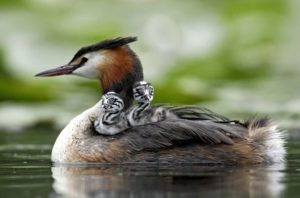 Easily recognisable with its black and double crested head, this beautiful bird lives on Lake Annecy during the winter when it leaves the northern regions. It feeds on small fish, crustaceans and insect larvae. It is a great swimmer, as it can dive to a depth of 20 m and from 2 to 6 m on average.
Easily recognisable with its black and double crested head, this beautiful bird lives on Lake Annecy during the winter when it leaves the northern regions. It feeds on small fish, crustaceans and insect larvae. It is a great swimmer, as it can dive to a depth of 20 m and from 2 to 6 m on average.
Bearded vulture
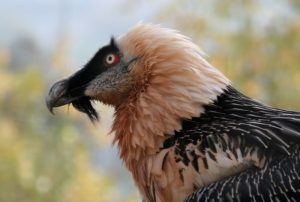 Nicknamed the Alpine vulture, this large bird of prey has a wingspan of almost 2.8 m. It was successfully reintroduced into the Alps a few years ago. It is a scavenger that feeds on bones, tendons and ligaments. The bird lives on its own until it reaches sexual maturity at around 4 to 5 years of age. It can be seen between 700 and 2,000 m altitude. It breeds from the age of 7 and a young is born every 2 years.
Nicknamed the Alpine vulture, this large bird of prey has a wingspan of almost 2.8 m. It was successfully reintroduced into the Alps a few years ago. It is a scavenger that feeds on bones, tendons and ligaments. The bird lives on its own until it reaches sexual maturity at around 4 to 5 years of age. It can be seen between 700 and 2,000 m altitude. It breeds from the age of 7 and a young is born every 2 years.
The golden eagle
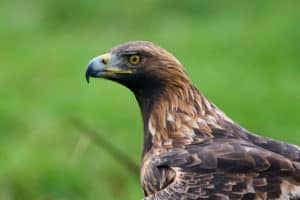 This magnificent predator occupies rocky landscapes and mountain pastures. In 2014, there were 41 pairs in Haute-Savoie. In winter, it can come down to the plains to hunt. Its hunting territory covers between 50 and 150 km². It is possible to spot it by positioning itself on a site that is sufficiently clear of vegetation.
This magnificent predator occupies rocky landscapes and mountain pastures. In 2014, there were 41 pairs in Haute-Savoie. In winter, it can come down to the plains to hunt. Its hunting territory covers between 50 and 150 km². It is possible to spot it by positioning itself on a site that is sufficiently clear of vegetation.
Griffon vulture
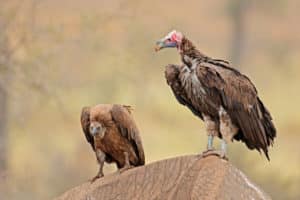 The griffon vulture is a bird that can be recognised by its white ruff and ash-brown coat. Its wingspan can reach 2.80 metres. It is a scavenger and does not pose a danger to humans. It can be seen in the heights of Sallanches, as well as in the Aravis, near Grand Bornand and in the Chablais, in the Morzine area.
The griffon vulture is a bird that can be recognised by its white ruff and ash-brown coat. Its wingspan can reach 2.80 metres. It is a scavenger and does not pose a danger to humans. It can be seen in the heights of Sallanches, as well as in the Aravis, near Grand Bornand and in the Chablais, in the Morzine area.
The snow partridge
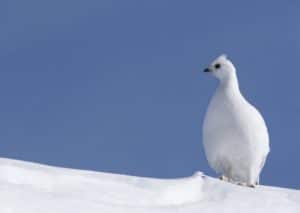 This bird lives between 1,800 and 3,000 metres above sea level in our mountains. Like the snow hare, its plumage changes colour in winter to become white, making it easier to escape predators. It is easier to find it on the ground because it does not fly when in danger. Also known as the rock ptarmigan, it can be seen in the Contamines-Montjoie nature reserve.
This bird lives between 1,800 and 3,000 metres above sea level in our mountains. Like the snow hare, its plumage changes colour in winter to become white, making it easier to escape predators. It is easier to find it on the ground because it does not fly when in danger. Also known as the rock ptarmigan, it can be seen in the Contamines-Montjoie nature reserve.
The black grouse
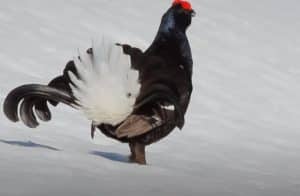 The black grouse is an emblematic bird of the Alps. Although it is mainly found in the Vanoise, Ecrins and Mercantour national parks, it is also present in Haute-Savoie. Although patience and luck are required, it is possible to see it in Manigod or Megève. In winter, quiet zones are set up to protect it.
The black grouse is an emblematic bird of the Alps. Although it is mainly found in the Vanoise, Ecrins and Mercantour national parks, it is also present in Haute-Savoie. Although patience and luck are required, it is possible to see it in Manigod or Megève. In winter, quiet zones are set up to protect it.
Aquatic fauna
Lake Annecy, like the rivers of Haute-Savoie, is full of fish. Several species are particularly sought after for their gustatory qualities. They feature on the menu of local gastronomic restaurants.
Arctic char
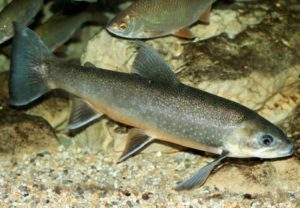 This large salmonid which can measure up to 40 cm and weigh 400 gr evolves in the depths of Lake Annecy between 30 and 70 m. Spawning takes place between November and January in protected areas of the lake: “the spawning grounds”. The fishermen catch it from a boat with a troll or a rod. Its flesh is highly sought after for its delicacy.
This large salmonid which can measure up to 40 cm and weigh 400 gr evolves in the depths of Lake Annecy between 30 and 70 m. Spawning takes place between November and January in protected areas of the lake: “the spawning grounds”. The fishermen catch it from a boat with a troll or a rod. Its flesh is highly sought after for its delicacy.
The trout
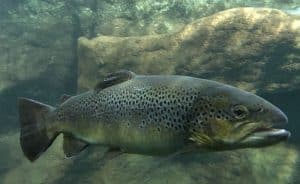 The trout is present in the rivers near Annecy, such as the Fier and the Laudon, as well as in the lake. This fish is also much sought after for its gustatory qualities. It feeds on worms, but also on other fish. During the authorised period, fishermen use the technique of natural or artificial bait.
The trout is present in the rivers near Annecy, such as the Fier and the Laudon, as well as in the lake. This fish is also much sought after for its gustatory qualities. It feeds on worms, but also on other fish. During the authorised period, fishermen use the technique of natural or artificial bait.
Perch
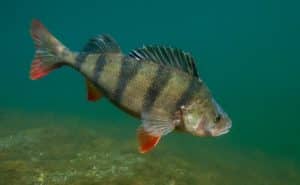 The body of the perch is grey-green and the flanks have 6 to 9 clearly recognisable dark transverse stripes. It can weigh up to 500 grams and is 40 cm long. Anglers catch them by casting or by shooting. Perch fillets are particularly popular in the restaurants around the lake.
The body of the perch is grey-green and the flanks have 6 to 9 clearly recognisable dark transverse stripes. It can weigh up to 500 grams and is 40 cm long. Anglers catch them by casting or by shooting. Perch fillets are particularly popular in the restaurants around the lake.
Pike
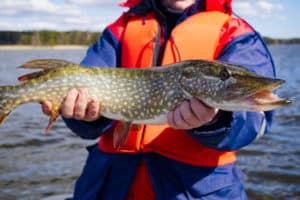 This is the great predatory fish of the lake, residing in the shallow grass beds to catch its favourite prey: fish, water rats and even small ducks. Its razor-sharp teeth are particularly effective. It measures between 40 and 80 cm on average, but in May 2009 an angler using a soft lure caught a 1.37 m pike nicknamed the “brocodile”.
This is the great predatory fish of the lake, residing in the shallow grass beds to catch its favourite prey: fish, water rats and even small ducks. Its razor-sharp teeth are particularly effective. It measures between 40 and 80 cm on average, but in May 2009 an angler using a soft lure caught a 1.37 m pike nicknamed the “brocodile”.
Perch
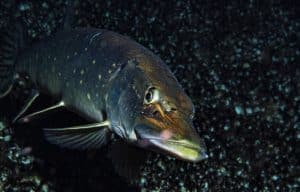 This is the most representative fish in terms of fishing on Lake Annecy. Its flesh is appreciated by the great starred chefs. This whitefish measures up to 60 cm for a maximum weight of 2.5 kg. This species was introduced into the lake during the 20th century. It feeds mainly on zooplankton and reproduces in the “spawning grounds”.
This is the most representative fish in terms of fishing on Lake Annecy. Its flesh is appreciated by the great starred chefs. This whitefish measures up to 60 cm for a maximum weight of 2.5 kg. This species was introduced into the lake during the 20th century. It feeds mainly on zooplankton and reproduces in the “spawning grounds”.
Crayfish
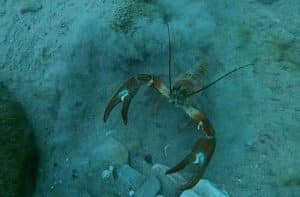 American and Californian crayfish have been present in the lake since their introduction in 1965. They feed on sedimented detritus. They can be seen by lifting stones underwater. Crayfish are enjoyed in local cuisine as a tail gratin or in bisque. The native red-footed crayfish has almost disappeared.
American and Californian crayfish have been present in the lake since their introduction in 1965. They feed on sedimented detritus. They can be seen by lifting stones underwater. Crayfish are enjoyed in local cuisine as a tail gratin or in bisque. The native red-footed crayfish has almost disappeared.
To discover the animal species of the Savoie, you can also visit the wildlife parks in the area.
















